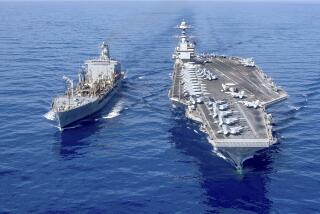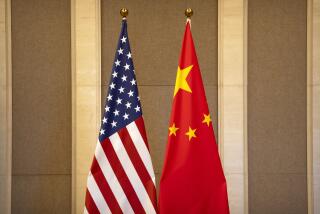America’s ‘Pacific pivot’ craze
Is there any organization outside of Hollywood more prey to intellectual fads than the Department of Defense?
A decade ago the buzzword around the Pentagon was “transformation.” Secretary of Defense Donald H. Rumsfeld wanted to force radical change to take advantage of information technology. So the individual services took to justifying every program, even hulking tanks and massive aircraft carriers, as “transformational.”
Then, as the armed forces became more deeply embroiled in Iraq and Afghanistan, the buzzword became counterinsurgency, or “COIN.” The Army and Marine Corps retooled themselves to fight insurgents. The Navy and Air Force felt left behind, so they took to rebranding everything they did as COIN-
related. I remember a fatuous briefing from an Air Force general in Afghanistan who solemnly informed me that his MPs were doing COIN around their own air base, which just happened to be located in one of the most insurgent-free areas of the entire country.
Now the buzzword du jour is “Pacific,” as in “Pacific pivot.” In January the White House released a new national security strategy, complete with italic emphasis: “While theU.S. militarywill continue to contribute to security globally, we will of necessity rebalance toward the Asia-Pacific region.” Since then, Secretary of DefenseLeon E. Panettahas announced that 60% of theU.S. Navywill gradually shift to the Pacific.
Naturally the Army and Marine Corps have been compelled to march in step. Gen. Raymond Odierno, the Army chief of staff, seldom lets a speech pass without noting that “seven out of the 10 largest armies are in the Pacific, and 22 of the 27 nations in the region have an army officer as chief of defense.” Hence, he argues, the Army has a vital role in building “relationships [that] will help us in the long run in the Pacific.” Not to be left behind, the Marine Corps has already dispatched 2,500 Marines to Darwin, Australia, where the greatest danger they are likely to face is alcohol poisoning.
Building up U.S. forces in the Pacific makes sense. China is a rising power and a potential long-term threat. But we don’t need a full-on “Pacific pivot,” at least not for the ground forces, because we can’t afford to neglect the Middle East, the center of our security concerns for more than three decades.
What should be rebalanced? Ships and aircraft. China, according to the U.S. Naval Institute, has been outbuilding us in submarines by 8 to 1 since 2005. A bipartisan commission calculated last year that the Navy would need 346 ships to meet its global commitments. But, as a result of budget cuts, the fleet is going to decline from 282 ships today to fewer than 250 in the next decade — and that’s not counting “sequestration,” the draconian mandatory budget cuts that are due in January unless Congress acts first. Similarly the Air Force has stopped buying the F-22, the most capable fighter in the world, and is steadily decreasing its planned buy of the next best, the F-35.
To be meaningful, the “Pacific pivot” would need to reverse the decline in procurement of aerial and naval weapons systems — and that, in turn, would require reversing the decline in the defense budget.
As for the Army and Marine Corps, shifting their focus to the Pacific would be ill-advised.
The only contingency that could call for a substantial deployment of ground troops to the region would be another Korean war or an implosion of North Korea — and even then, the large and capable South Korean forces would be in the lead, with the U.S. primarily providing intelligence and air power. Korea aside, the Army and Marines in the Pacific will in all likelihood be limited to exercises with allied ground forces. No one imagines U.S. troops marching on Beijing.
So does this mean that we have no need for a large ground force and can afford to cut Army and Marine Corps troop levels by 100,000, as currently planned? No, because the greater Middle East — a region stretching from Mali to Pakistan — remains in turmoil. U.S. troops are still fighting in Afghanistan, and it is not hard to imagine scenarios under which they may need to be sent to Pakistan, Iran, Libya, Yemen, Syria, Somalia or other countries.
Groups such as Al Qaeda in the Arabian Peninsula are constantly plotting attacks on American aircraft and the American homeland. If even one of them succeeds, there could well be inexorable pressure to clean out the terrorist sanctuaries — and the Army and Marines could be sent into battle again.
Instead of pushing the Army and Marine Corps to pivot to the Pacific, the administration would be better advised to recognize that for the U.S., the Pacific will remain primarily an air and naval theater. By all means, increase our air and naval assets in Asia, but leave the Army and the Marines free to concentrate on the area where they have been so heavily engaged in the last decade and are likely to remain engaged for years to come.
Max Boot, a contributing editor to Opinion, is a senior fellow at the Council on Foreign Relations and the author of the forthcoming “Invisible Armies: An Epic History of Guerrilla Warfare from Ancient Times to the Present.”
More to Read
A cure for the common opinion
Get thought-provoking perspectives with our weekly newsletter.
You may occasionally receive promotional content from the Los Angeles Times.






